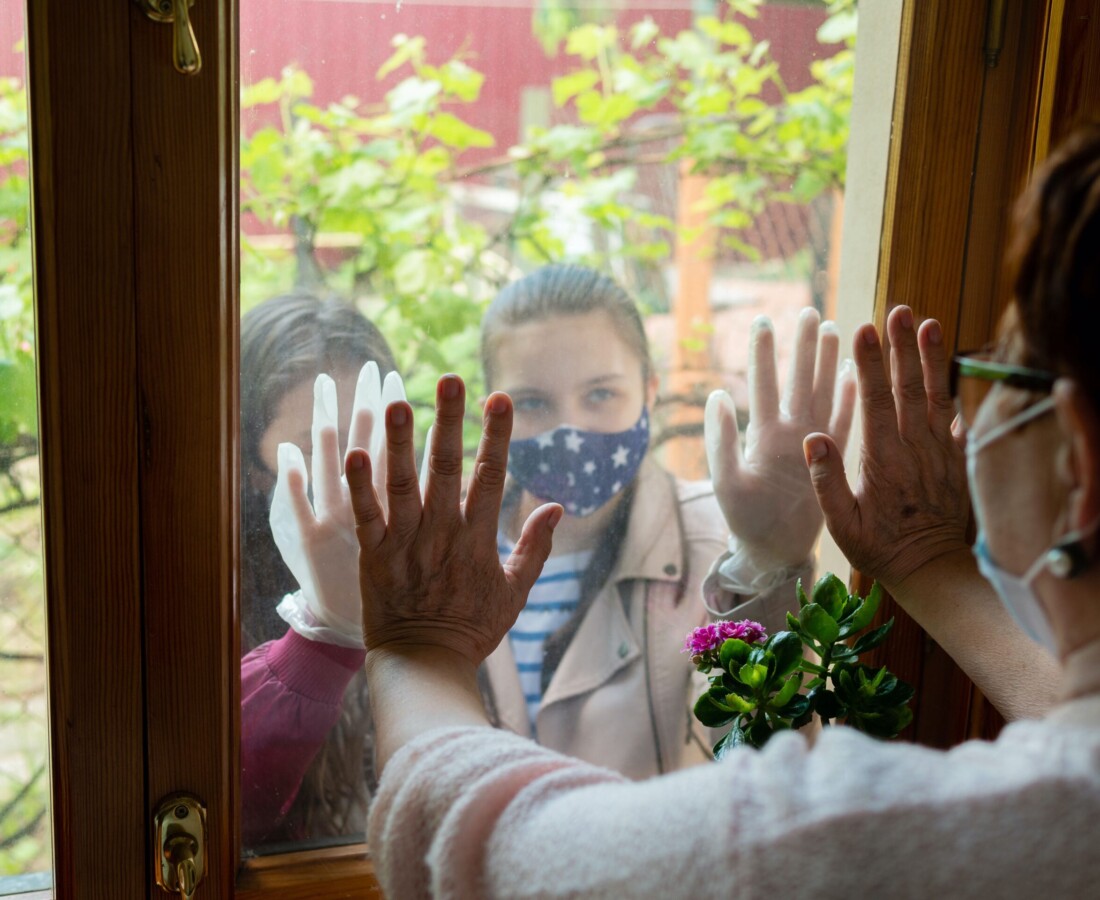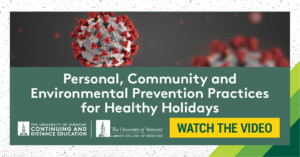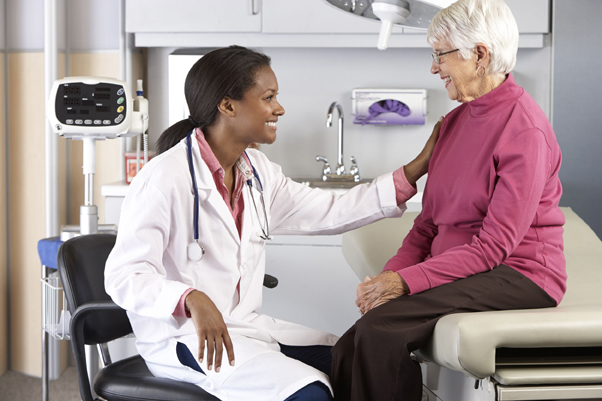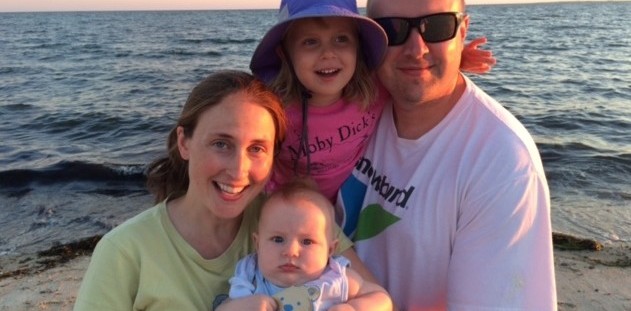On October 31st, the U.S. reported 99,321 new coronavirus cases—the highest single-day total since the beginning of the pandemic—and the near-future doesn’t look promising. The Center for Disease Control and Prevention (CDC) predicts a total of 243,000 to 256,000 COVID-19 deaths will be reported by the week before the Thanksgiving holiday, up from 229,000 at the time of this publication.
When Americans are living through the darkest days of the pandemic and confronted with a possible twindemic—how are we to safely navigate the upcoming holiday season, heavy on tradition and obligation, centered on contact and connection, and often requiring us to travel across state lines to see loved ones?
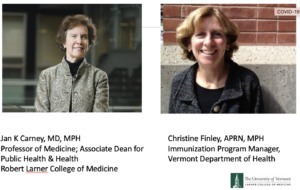 To address some of these concerns, UVM Continuing and Distance Education along with the Larner College of Medicine, recently hosted a free, informational webinar on current COVID-19 data, measures to deal safely with the upcoming flu season, and strategies for cautious celebrations from Thanksgiving through New Year’s, led by Jan Carney, M.D., MPH, Associate Dean for Public Health and Health Policy and Senior Advisor to the Dean, and Christine Finley, MPH, Vermont Department of Health’s Immunization Program Manager.
To address some of these concerns, UVM Continuing and Distance Education along with the Larner College of Medicine, recently hosted a free, informational webinar on current COVID-19 data, measures to deal safely with the upcoming flu season, and strategies for cautious celebrations from Thanksgiving through New Year’s, led by Jan Carney, M.D., MPH, Associate Dean for Public Health and Health Policy and Senior Advisor to the Dean, and Christine Finley, MPH, Vermont Department of Health’s Immunization Program Manager.
Help Protect Yourself, Your Loved Ones, and Your Community with a Flu Vaccine
During the 2019-2020 flu season, the CDC estimates that 24,000-62,000 people died from influenza. “This season,” Carney said, “We’re making a real push, and the mantra is: the flu vaccine is more important than ever.”
Though a flu vaccine will not protect you from the coronavirus, they have been shown to reduce the risk of flu illness, hospitalization, and death. With hospitals likely dealing with an increase in COVID-19 cases over the next several months, experts are urging people to vaccinate to help conserve potentially scarce healthcare resources.
“We’re greatly expanding the work we’re doing with the flu vaccine this year in order to prevent what some people call a ‘twindemic,’” Finley said. “I don’t think any of us want to be in the position where we think we have the flu and/or COVID. So one of the things we’re doing that’s very interesting is we’re providing vaccine as we always do at no cost for children and adults or those that are enrolled, but we’ve also provided support for practices to do off-site clinics and they have taken it and run with it […] what we’re seeing so far is an uptake in kids is higher than we saw last year, and one of the challenges we have with the flu vaccine is we tend to have one of the lowest rates, not only in region 1 in New England, but across the U.S., and where we’ve seen the lowest are particularly in the 13- to 17-year age range and then in the 18-49. And when I say low, that’s less than 40 percent.”
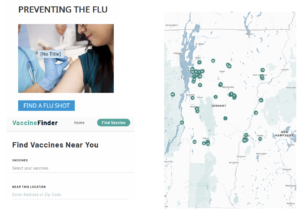 In order to remedy this, Finley said that the Vermont Department of Health has worked diligently to improve access, including offering vaccines at no cost to those without insurance and encouraging individuals and families to use vaccinefinder.org to locate the nearest provider.
In order to remedy this, Finley said that the Vermont Department of Health has worked diligently to improve access, including offering vaccines at no cost to those without insurance and encouraging individuals and families to use vaccinefinder.org to locate the nearest provider.
Celebrating Holidays Safely as COVID-19 Trend Upward
“We’re seeing an increase in disease here in the Northeast,” Carney said. “And some of the concerns are that we are going to see more and more disease pop up in the smaller family and friend gatherings, particularly around the holidays—so we have to rethink that. If your usual holiday gathering on Thanksgiving is to have 35 people in an 8×10 room, well, pause. Think about that. Can you spread those gatherings out over several days? Can you have fewer people? Can you space out the chairs? Can you remind people to wear masks? Or even stay home and not be offended by those conversations?”
In considering whether or not to participate in holiday celebrations, Carney encourages people to think about the following:
- Community levels of COVID-19
- Location of the gathering: indoor vs. outdoors
- Duration of the gathering
- Number of people: more people = higher risk
- Where are people traveling from?
- Behaviors of attendees (e.g. are they wearing a mask or not)
- Your ability to quarantine or get tested for COVID upon returning home
People who should not attend in-person holiday celebrations
People with or exposed to COVID-19
Do NOT host or participate in any in-person if you or anyone in your household:
- Has been diagnosed with COVID-19 and has not met the criteria for when it is safe to be around others
- Has symptoms of COVID-19
- Is waiting for COVID-19 viral test results
- May have been exposed to someone with COVID-19 in the last 14 days
- Is at increased risk of severe illness from COVID-19
People at increased risk for severe illness
If you are at increased risk of severe illness from COVID-19, or live or work with someone at increased risk of severe illness, you should attend activities with lower risk.
Resources to Stay Informed
Although the best prevention is staying home, both Carney and Finley acknowledge that many people won’t, and that’s it’s simply not practical to imagine that Americans will forgo all holiday travel and visitations.
“The reality is that people do need to see each other,” Finley said. “I have a 92-year-old father who lives in central New York and family there who all work in the healthcare industry and I find that you have to look at the information and make your decision. I know that if I need to go, I have to quarantine after. I have all the specifics down […] If you follow the CDC or Health Department guidance, you’re basing it on a lot of research that’s been done and what we know to date. There’s clear guidance so you’re not left out, trying to figure out what to do.”
Dr. Carney continues to encourage the use of scientific resources for the most current information, especially as the news shifts quickly related to the pandemic:
- CDC: Coronavirus 2019
- World Health Organization
- Vermont Department of Health
- New England Journal of Medicine Summary of Articles on Coronavirus
Learn more about careers in Public Health and UVM’s online Master of Public Health Program.

